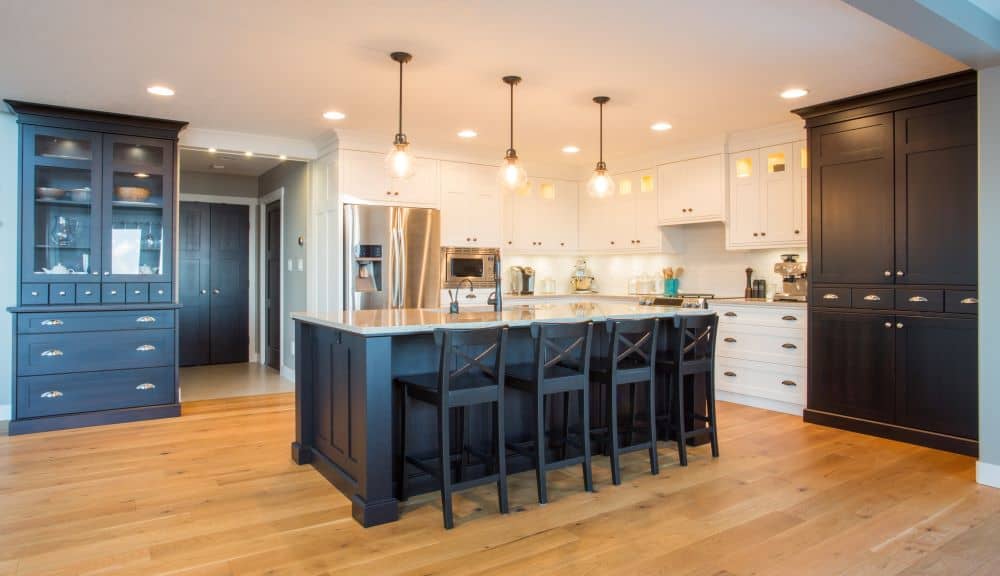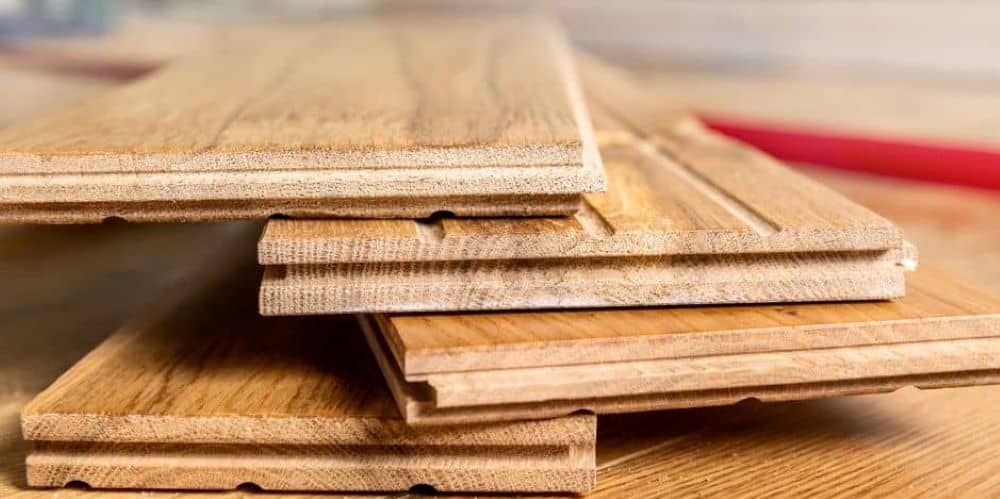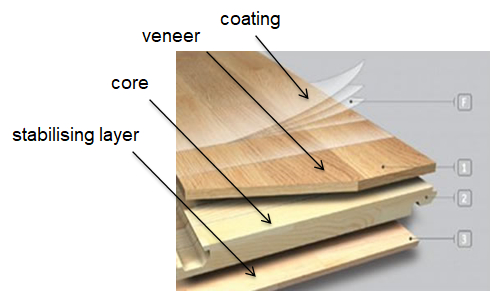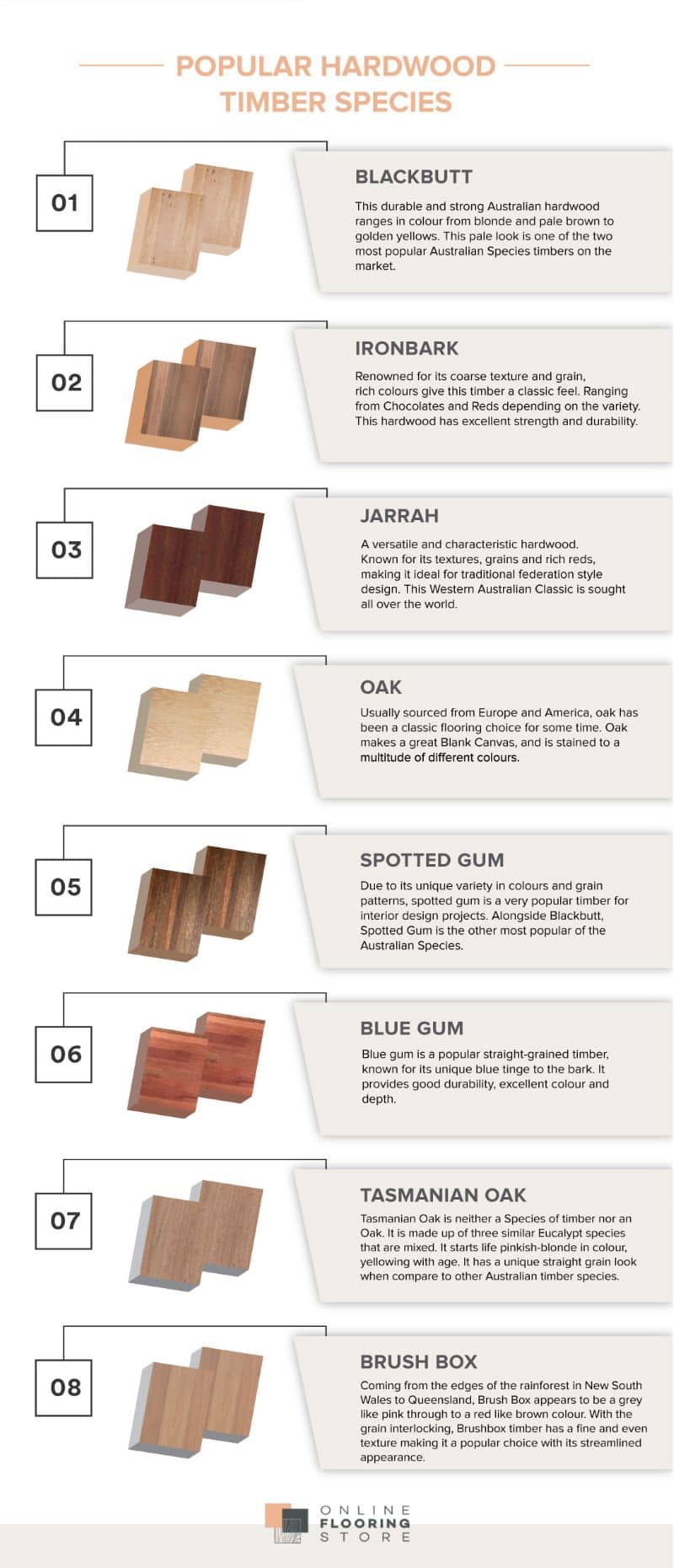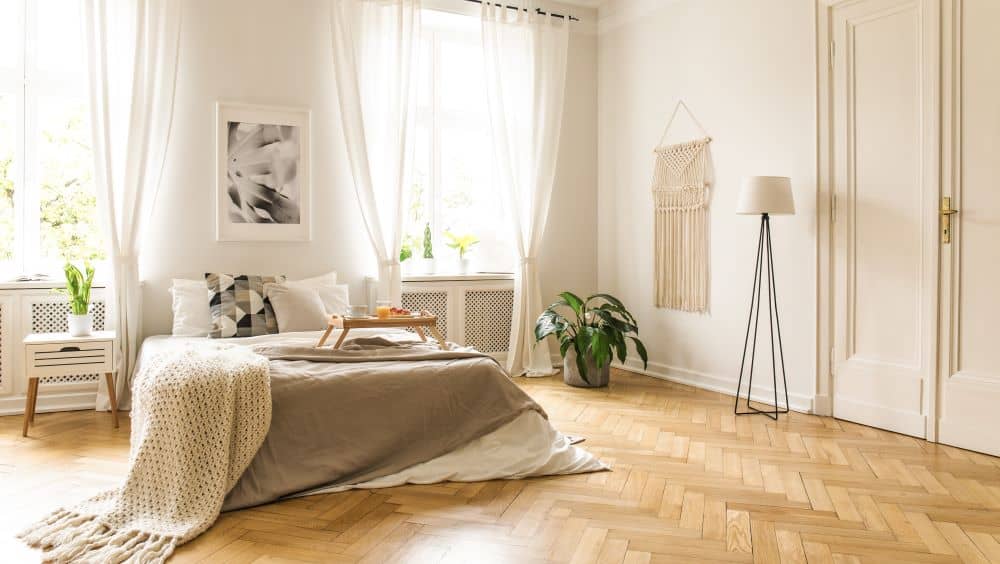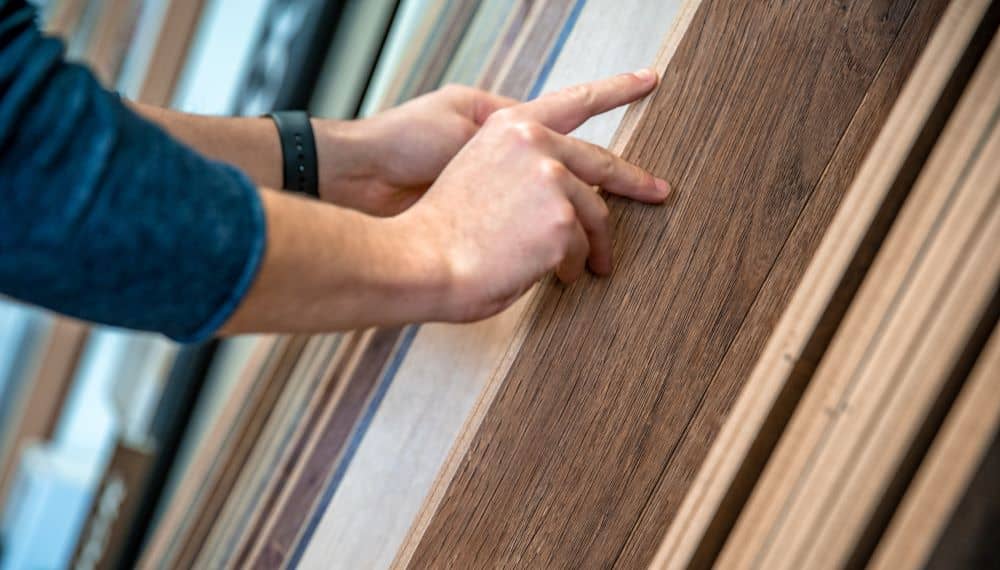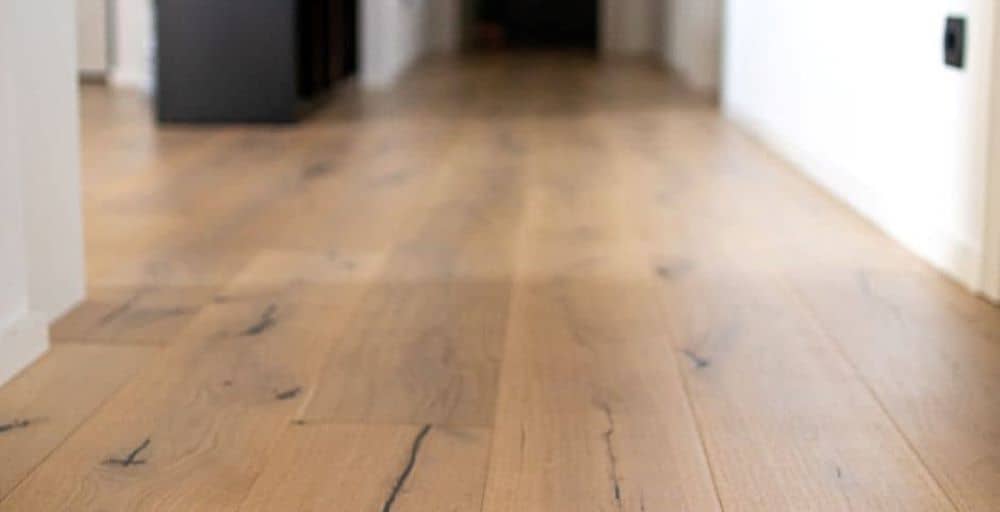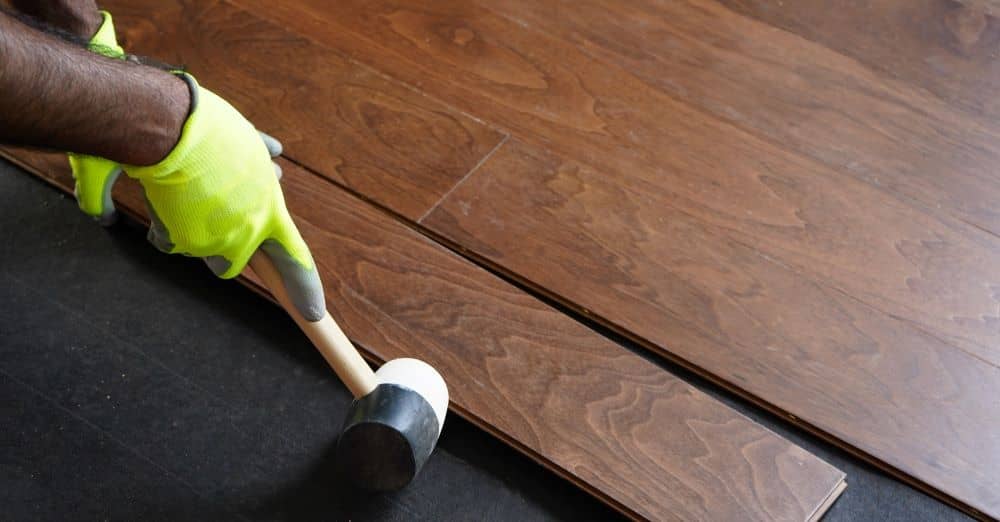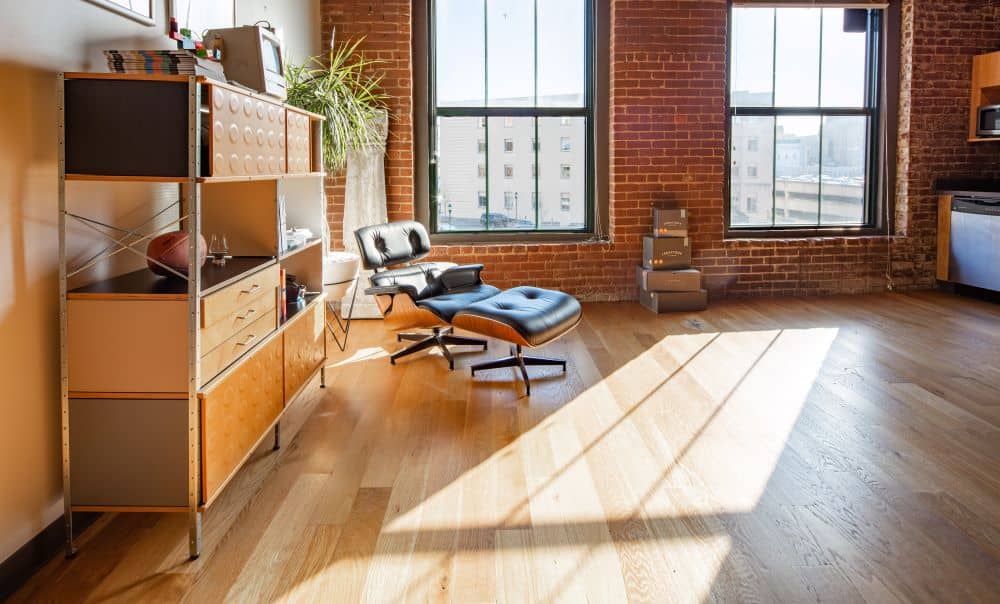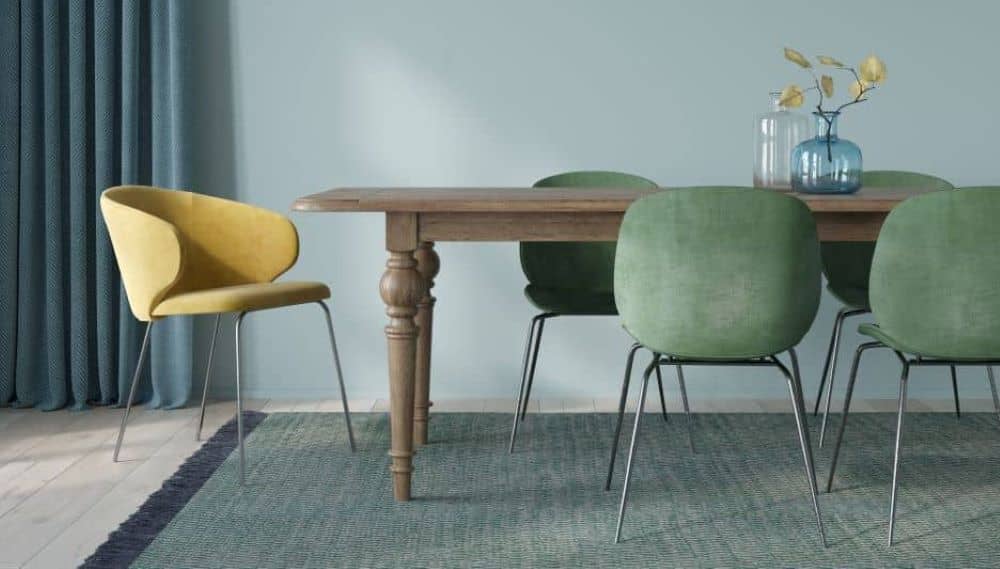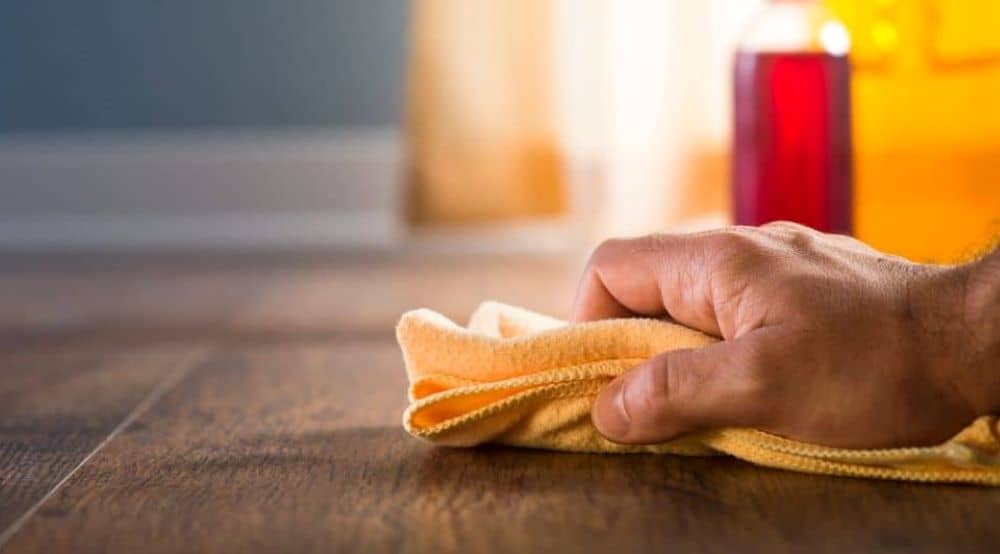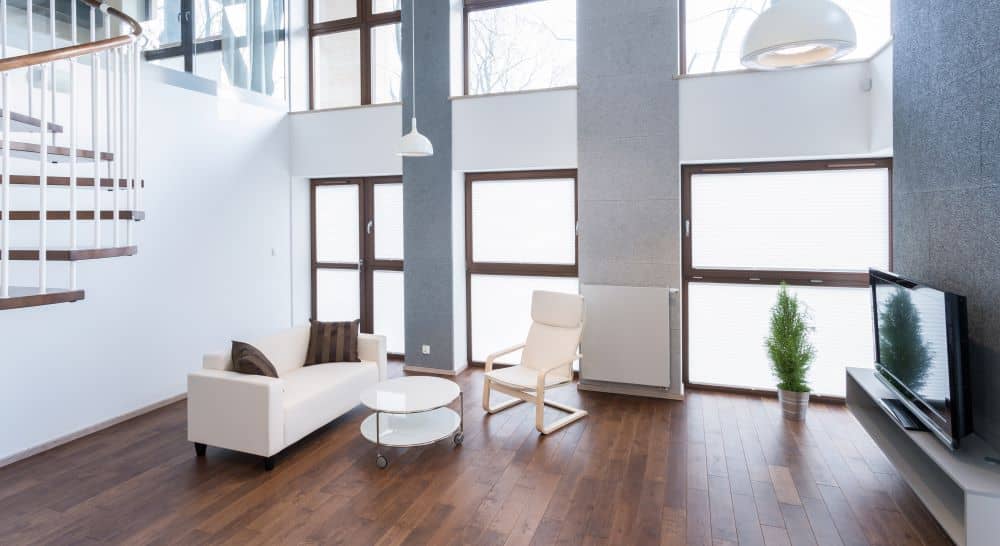Timber flooring is a versatile and much sought-after flooring material that has stood the test of time. With its unique natural beauty, warmth, luxury, elegance, and rich character, it is a common flooring material for homeowners to gravitate toward.
If you are considering timber floors for your home, we have put together an extensive guide to understanding solid timber and hardwood flooring.
Learn below about every aspect of timber flooring and find out if it is the right flooring material for your space:
What Is Solid Wood Flooring?
Solid wood flooring, as the name implies, consists of 100% solid wood throughout its entire thickness. It consists of a single piece of timber that gets cut from a log and is then kiln dried and profiled into solid timber flooring. It is typically made from hardwood species, but it can also be made from softwoods.
What Is Engineered Timber Flooring?
When a piece of timber is cut and laminated to other types of timber, this is referred to as engineered timber.
Engineered timber usually consists of multiple layers of material and can be manufactured in several ways. For example, the top layer may feature Spotted Gum, with the core being made of another timber species in the middle running at a 90-degree angle to the top layer, with a third species of timber as the backing or stabilising layer running in the same direction as the top layer.
Since timber typically grows more on the width than on the length, the top veneer is wanting to grow on the width, but the Core layer (laid at a 90-degree layer to the top) also wants to grow on its width. This design ensures the two layers naturally restrain each other. The backing layer then helps to balance out the forces of the top layer and keep the system as a whole in balance.
Differences & Similarities Between Solid Timber & Engineered Timber
If a solid wood floor is 18mm or more in thickness, it can be used as a structural floor. Engineered floors cannot be used structurally, and can only ever be used as an overlay.
Both floors have the potential to be sanded and refinished throughout their lifetime. Both Solid and Engineered timber can typically be refinished up to 4 times. For example, if an engineered timber floor has a veneer that is 4mm thick, it can be refinished roughly once every 10 years, given it a 40+ year lifetime.
This however depends entirely upon the thickness of the veneer of an Engineered Timber Floor. For example, a Micro-veneer engineered timber with a .6mm veneer can never be sanded and recoated, whereas a 6mm veneer can be sanded more than was mentioned above.
When a solid wood floor is made, the manufacturer’s typically cut a tongue and groove profile into the plank to allow the floor to be joined easily and accurately. The timber that sits above the tongue of the floor is generally 4mm thick. This means that a solid timber floor can generally only be sanded and recoated as many times as an engineered timber floor with a 4mm veneer.
While the options for solid timber floors are practically endless, engineered timber floors are typically more limited in terms of styles and colour options because Engineered Timber Floors are typically prefinished, and Solid Timber Floors are typically finished on site after they are installed.
Download our Ultimate Guide to
Understanding Timber Flooring
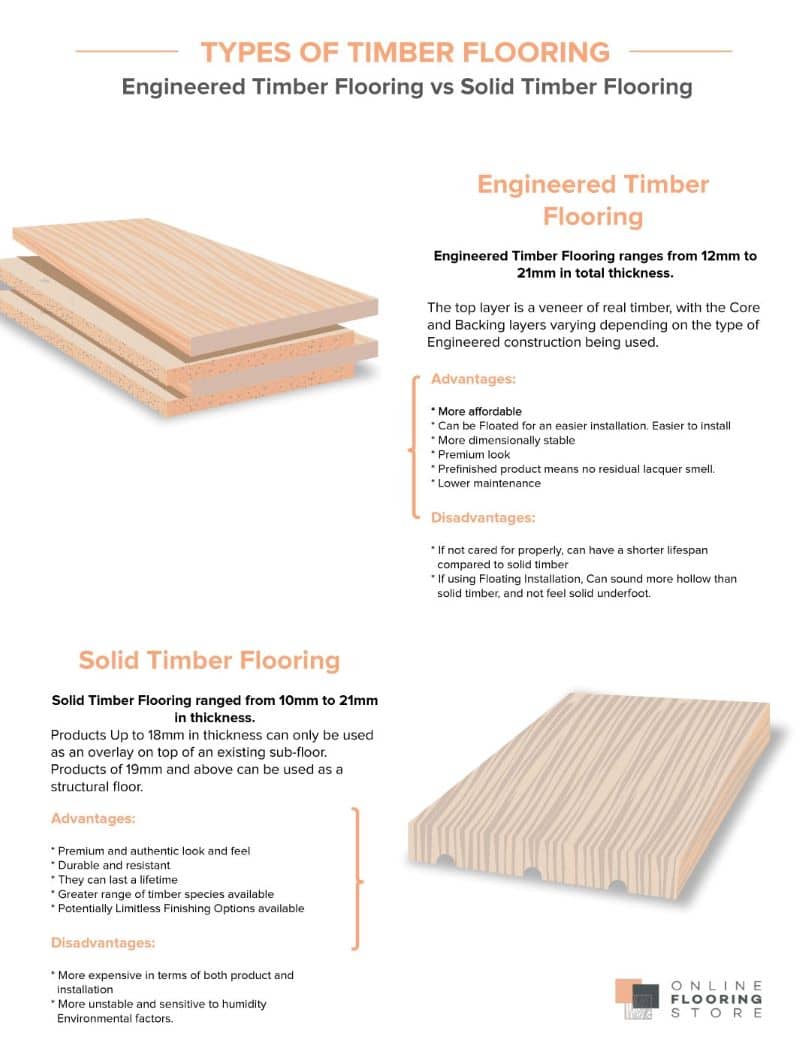
The Difference Between Solid Timber Flooring & Hardwood Flooring
Solid Timber simply refers to a product being cut as a single piece of timber. While solid timber is typically made from hardwood species, solid timber can also be made from softwood species, such as Pine.
In solid wood, the grain all runs in one direction, so timber moves and shrinks as a single piece of timber.
Hardwood refers to one of 2 categories into which timber is classified. Solid Timber can be made from either hardwood or softwood, with Hardwood being more common. Engineered timber sometimes uses softwood in its construction but never in the veneer that makes the top layer.
What Is the Difference Between Hardwood and Softwood?
It is generally thought that the difference between ‘Hardwood’ and ‘Softwood’ lies in the hardness of the timber. This however is a misconception. While it is an accurate assumption in most cases, it is not technically correct as ‘Balsa’ is a hardwood (a very light wood)! The difference is on a botanical level and is found in the type and structure of the trees themselves.
Softwoods are referred to as ‘Gymnosperms’ and are typically more ancient kinds of trees. They are typically evergreens, meaning that they do not shed their leaves (or nettles,), and have open seeds that are often in cone-like structures. Hardwoods on the other hand are much less ancient than Softwoods and are referred to as ‘Angiosperms.’ They are typically deciduous, and produce seeds inside of ripening fruit.
While all of this is what typically differentiates Softwoods from Hardwoods, the one thing that all hardwoods have that is absent is Softwoods is a kind of structure known as a ‘Vessel’. These are much wider than the standard fibres present in both Softwood and Hardwood. This gives Softwoods a more ‘Simple’ structure than Hardwoods have.
Having said all of that, it is generally true that the timber of a Hardwood will generally be stronger, harder and denser than Softwoods. But remember, as in the case of Balsa, that this is not always the case.
When comparing hardwood vs softwood in terms of hardness in timber flooring, the Janka rating measures density by pressing a ball bearing into the timber until it is half submerged. The Janka rating is then measured by the number of Kilonewtons of pressure required to submerge this ball bearing to this point.
Based on this ball bearing test, a timber species is given a number on the Janka scale from the Kilonewtons of pressure used to imbed this ball bearing. Basically, the higher the number, the harder the timber.
For instance, Spotted Gum in its different variants ranks around a 10 to 11 on the Janka scale while different kinds of pine rank around 2 to 4.
Common Hardwood Flooring Species In Australia
Most often, we see Spotted Gum, Black Butt, and Oak (typically European) species used for flooring applications. Spotted Gum and Blackbutt are favoured for their natural colour and feature, whereas Oak is commonly stained in many and varied different colours. For more on common Australian timber species used in flooring, see this blog.
The Different Types of Hardwood Flooring
In Australia, the most common species of timbers used are those of the Eucalypt family. Most Commonly used are Spotted Gum and Blackbutt in their different variants. This is followed by Brushbox, Ironbark (both Grey and Red,) Tasmanian Oak (which is made of at least 3 different species and is not an Oak,) Blue Gum and Jarrah. Many other variants of Gum, Box and Ash timber are also used, but these are far less common and generally limited to Solid Timber Flooring.
It is also produced in several formats, such as Strips and Planks which vary on their thickness. Some are profiled for with a tongue and groove for Secret Nail or Direct stick application, or square dressed for a top nail application. Parquetry is also available in both Block form which is larger pieces that can be used for Chevron and Herringbone installations, and Mosaic which are made of smaller pieces of timber assembled into squares.
What Are the Pros of Solid Timber Flooring?
Solid timber floors feature a host of benefits, making them an ideal choice for a variety of scenarios, design styles, and settings.
1. Longevity
When homeowners install Timber flooring, they are investing in a material with the potential to last for many lifetimes. Although the initial investment is higher, timber flooring often pays for itself over time by outliving other types of flooring. Not only does it outlast other kinds of flooring, but it will also look better for longer. Synthetic floors deteriorate from the moment you lay them. Timber floors that are well maintained become better with age!
Along with their durability, timber floors feature a timeless appearance that never goes out of style. Other (typically synthetic,) flooring materials that are produced to meet rapidly changing trends can easily date a home. Timber floors tend to avoid trends and stand in a class of their own.
Better yet, if you do grow tired of a certain colour, the appearance can be changed by sanding and re-coating. If you choose a whitewash colour and decide 10 years later you want to go the opposite route and have rich, darker tones, you can sand a timber floor and refinish it in whatever style you choose.
2. Aesthetic Appeal
Timber is arguably the most beautiful flooring available. Because timber is a naturally sourced material, no two planks will ever be alike.
This variety between planks gives timber flooring an authentic, character-rich appearance that is simply unmatched in its beauty. Each plank will feature slight variations in grain pattern and subtle differences in texture and shade
With recent advances in technology, Vinyl, hybrid and especially Laminate Flooring can replicate the look of real timber to the point that it can appear to be the same to the untrained eye. While these types of flooring can appear almost as beautiful as real timber, pattern repeats mean you will see the same board over and again on your floor if you go looking for them. With Real timber, no two pieces are the same…… ever!
3. Variety
Along with immense variations and character in each plank, Timber Flooring is also available in an almost endless variety of finishes and colours.
Whether you prefer dramatic whitewashed floors, classic colour tones, flat dressed or hand scrapped surface finishes, it is possible to find a timber flooring that matches exactly what you are searching for.
Along with the almost endless colour and style options, there is a wide range of coating options including polyurethane lacquer, oil, hard wax oil, etc. available for unfinished timber. Each coating results in a different appearance, maintenance regime, and has its advantages.
For example, if you choose an Oiled finish on your floor, you may never have to sand and re-coat it. Instead, you will need to follow an oiling regimen. Oiling timber nourishes the wood and keeps it (indefinitely) healthy, enhancing its elegant appearance more with age.
On the other hand, by Lacquering a timber, the Lacquer forms a solid shield across the top of the floor, protecting the timber from the ingress of moisture and other invasive objects that can cause timber to deteriorate.
In Australia, Lacquering is the most common finish on both solid and engineered timber floors because it does not require the constant maintenance that an oiled floor does. However, in Europe, Oiled Finished are more common.
4. Lasting Quality
When properly maintained, timber flooring will look better with age. Where other flooring options may feature a shelf life of 20 or so years and begin the process of deterioration from the moment they are laid, timber’s timeless look and durability mean you may never have to re-install new floors.
Certain finishes such as oiling or lacquering lend themselves particularly well to timber floors that will last a lifetime. When maintained regularly, timber has a way of aging in the most beautiful way that will leave you with floors that look better decades from now than when they were first installed.
5. Improved Home Value
Because buyers know the longevity and benefits that come with timber floors, this sought-after flooring material will almost certainly add appeal and value to your home.
While certain flooring materials appeal to a limited market, timber flooring offers a broad appeal. And as mentioned previously timber is timeless. Where a 30cm x 30cm terracotta tile will often be the tell that a house was built in the late Ninety’s or early Naughty’s, a timber floor will very rarely be an indicator as to the age of a house.
6. Healthier Air Quality
Hardwood flooring doesn’t trap dirt, debris, and allergens the way some flooring materials do, in a particular carpet. Timber flooring is considered non-toxic and also does not harbour parasites or allergens such as dust mites, fleas, animal dander, or spores. This helps attain a cleaner, healthier indoor environment compared to other types of flooring.
Also, dirt and debris are more easily seen on hardwood flooring, making it simple to clean up immediately. It’s what you don’t know is there that gets you!
7. In-Floor Heat Friendly
Timber floors work particularly well with in-floor heating systems provided that the manufacturer’s instructions are followed. Along with the warm, inviting appearance of timber floors, installing your timber flooring in colder states along with in-floor heating offers warmth underfoot and a soothing atmosphere.
Cons of Solid Timber and Hardwood Flooring
Knowing both the pros and cons of particular flooring material is essential to deciding on the best flooring for your home. While hardwood floors offer a vast array of benefits, there are some drawbacks to be aware of.
1. Installation
If you are not particularly handy, we recommend hiring a professional flooring tradesman for installation over DIY installation, but for the installation of Solid timber flooring, we will always recommend you hire a professional tradesperson as this is not considered a DIY product.
An immense number of considerations and factors go into determining and completing the proper installation of timber floors. If the wood is not allowed to acclimate to its new environment or insufficient expansion or contraction is allowed for.
Several negative consequences can arise such as:
- Damage to the flooring itself (this can lead to a need for sanding and refinishing or even for complete reinstallation over time)
- Damage to surrounding structures including walls and fixtures being pushed out of place
Subpar appearance - Reduction in durability of the flooring and increased susceptibility to damage
The cost of having to repair any mistakes, which may end with the floor having to be paid for twice!
To avoid these potential pitfalls, it is crucial to hire a trusted, professional installer (we can connect you with over 200 tradesmen throughout Australia) — to avoid the pitfalls that come with incorrect installation.
2. Cost
Solid timber flooring is one of the most expensive flooring materials available, especially when compared to vinyl or carpet. However, bear in mind that quality timber floors can last a lifetime, making the cost a worthwhile investment in the long run.
3. Small Potential for Termites
This is a fairly small concern, especially if you opt for hardwood flooring over softwood as termites prefer softer woods that are easier to eat. If termites are a great concern to you, Australian Eucalypt species such as Spotted Gum, Blackbutt or Ironbark would be your best choice.
4. Susceptibility To Damage From Water and Environmental Conditions
All timber flooring is susceptible to damage from water or environmental conditions such as extreme fluctuations in humidity and temperature. Typically, more humid conditions cause timber to grow, and dry conditions cause it to shrink.
A skilled installer will know how to consider environmental conditions to allow both correct acclimation of the product and the correct room for shrinkage and expansion. This knowledge is something that is accumulated over years and cannot be learned from a youtube video.
5. Scratches
As with just about any flooring material, scratches are a concern for timber floors. Fixing scratches can be expensive, although scratches on oiled timber floors are usually easier to address.
To protect your hardwood floors, be sure to:
- Take your shoes off before entering the house and have guests do the same. Small rocks picked up in shoes can scratch the coating on timber flooring very easily.
- If you are opting for a flat dressed timber, then c
- If you are going for an Oak or softer hardwood, always ensure it is hand-scraped as this will hide to a large degree the ‘Signs of passage’ that occur over time.
- Placemats at entryways.
- Use furniture pads under all sofas, stools, and chairs.
- Do not slide heavy items over the floor. Always lift them.
- Use rugs in high traffic areas.
- Avoid plastic-wheeled furniture or trolleys.
- Keep your pet’s nails properly trimmed and groomed.
6. Limited Usage
Certain flooring materials are suitable for some rooms and not others. With hardwood flooring, it is generally not recommended for installation in rooms susceptible to high moisture or frequent spills such as:
- Bathrooms
- Laundries
- Toilets
If you are searching for the best flooring for high moisture areas of the home, feel free to read our in-depth blog discussing the best flooring for wet surfaces.
7. Cupping and Crowning
Cupping is a phenomenon where the sides of a timber plank grow and are higher than the centre of the plank. Crowning is the opposite, where the centre of a timber plank grows higher than the edges of the plank. These Phenomena can occur for 2 reasons.
The first reason is due to moisture ingress and usually manifests as cupping. This normally happens in times of extreme humidity, as timber usually takes in moisture through the sides and ends causing them to swell first. This can happen in areas where the humidity is usually high with a high temperature, or as a result of flooding the floor.
The second reason is due to excessive growth in the floor beyond that which expansion has been allowed for. This will usually manifest as both cupping and crowning, as the wood changes shape to accommodate the excessive growth.
To avoid cupping or crowning, always wipe up spills immediately and be sure to hire a professional installer to properly acclimate the flooring before installation and adequately plan for necessary expansion. Once the floor grows beyond this amount, it must release this energy somehow, and this occurs as pressure builds up in the floor.
Boards can cup or crown depending upon what is easiest for them. They will typically follow their grain structure in this instance. If the grain structure is Concave, then the timber will generally cup, and if it is convex, it will generally crown. In extreme cases, fixtures and even walls can be pushed out of place.
An experienced Timber Flooring Installer will know how to alleviate these issues before they occur.
8. Sustainability
If sustainability is a priority for you, engineered timber floors may be your ideal timber flooring choice. Essentially, engineered timber makes the most of trees by minimising the amount of rare, expensive timber used for each board.
For instance, a 14mm engineered Spotted Gum Plank with a 4mm veneer, has its other layers made from plantation grown trees that were specifically grown to be harvested for this purpose. Comparing this to a 14mm solid overlay Spotted Gum plank, the Engineered option uses only 28.5% of the slow-growing Spotted Gum that the Solid option does.
9. Acoustics
Floated Engineered Timber flooring can be somewhat noisy when walked on. Installation can play a role in sound reduction. If this issue is important to you, feel free to reach out to us for more information on flooring acoustics or talk with your tradesman about potential ways to make your timber flooring quieter underfoot before it gets installed.
10. Maintenance
While caring for solid timber or engineered timber flooring is generally quite simple, there are considerations when it comes to maintaining timber floors and keeping them looking beautiful and healthy over the long-term.
It is important to sweep and vacuum regularly to keep timber floors free of dirt, sand, debris, and dust. We also highly recommend taking your shoes off inside to prevent small particles on the bottoms of shoes from scratching the coating on the floor.
It is also essential to wipe up any spills as quickly as possible. Floors need to be mopped (usually weekly) using a microfibre cloth specifically designed for wood floors. Damp mopping can also be used. Just don’t let hot water sit on the timber for too long and give it a chance to start making its way into the timber. When vacuuming, do not use a brush roller as it can lead to scratches.
Always use cleaning agents according to the manufacturer’s recommendations, only use products specifically recommended for timber flooring, and follow instructions thoroughly. For instance, using more cleaner than recommended can lead to build-up that can trap debris and lead to a dull and dirty look on your flooring.
For more information on how to care for timber floors, please reference our blog on hardwood floor maintenance.
11. Transportation
Solid timber often comes in random lengths in longer pallets that require a crane, making transportation potentially difficult. Alternatively, engineered timber planks are cut to fit into boxes that can easily be transported.
12. Availability
At times, limited availability may drive the price of certain species up. Availability may also change based on the time of year. Also, certain mills do not like working with species like Iron Bark and Brushbox, as they find them difficult to work with.
Do You Have Questions on Solid Timber or Hardwood Flooring?
We know how difficult it can be to sort through all the information when it comes to choosing the best flooring for your home or business. Our caring, experienced team is here to help. We love talking flooring with our customers!
From manufacturing questions to installation guidance to design and decor and everything in-between, one of our experts will gladly answer all of your flooring questions.


